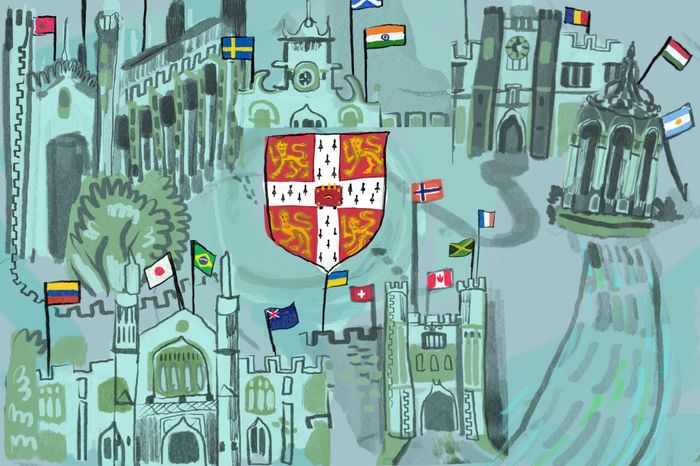Caerdydd to Caergrawnt: what is it to ‘be Welsh’ in a home away from home?
Olivia Goodman speaks to Welsh students at Cambridge about preserving their national identity

I remember those last days leading up to Cambridge move-in: saying goodbyes, shopping lists completed, ready for the five-hour drive ahead of us. It hit me when I passed the Severn Bridge, staring at the two sides and the water in between, I was heading in a new direction. But, yes, I had my Welsh cakes securely packed. It was non-negotiable for my family, ensuring I had some Welsh memorabilia. “To take a bit of Wales with you,” they said, placing the packet in my hands.
The ‘Staircase tea party ’ was scheduled first on our freshers’ timetable. I knew exactly what to bring. I sat, gazing at the packet adorned in all its iconography: red, white, green, the dragon, and the Welsh lady. Who knew a packet of Welsh Cakes would be my muse to explore my Welsh identity?
“It was non-negotiable for my family, ensuring I had some Welsh memorabilia”
I had never thought much about my identity before I came to Cambridge: being Welsh was my normality. I’m not Welsh-speaking, not all of my family are Welsh, and I was born and raised in the multicultural, cosmopolitan capital city of Cardiff. Although I found myself navigating what Welsh identity means for me, I was curious about what it means for other Welsh students in Cambridge.
Cristyn Davies, an MML student at Christ’s College, said, “I think that being Welsh is not about being fully Welsh-blooded nor knowing the language, but rather having pride in the culture and the traditions.” Wales is a small country. Yet, there are contrasts in Wales: North and South, rural and urban, Welsh-speaking and non-Welsh speakers. Each faction showcases the different facets that form Welsh Identity. The Welsh stereotype may consist in our accent, the sheep, and Gavin and Stacey references, but beyond that, there is a unique cultural and historical Welsh story behind each Welsh person.
For HSPS student Carys Williams at Murray Edwards College, her connection with her heritage is anchored by “my bampy, who I spent a lot of time with growing up and have always seen as being very Welsh—he knows the language, is very involved in Welsh culture.” For anyone confused, the term ‘Bampy’ is what we call our grandfathers. I have often used such Welsh colloquialisms and forgotten to provide context. Bella Palombo, a law student at Medwards, agreed. She said she misses “Welsh colloquialisms a lot, I’m really used to using phrases like ‘cwtch’ and ‘I’ll be there now in a minute’, which make sense back home but sound very alien to people in Cambridge!”
For Steffan Nicholas, an English student at Sidney Sussex, pride in his Welsh heritage and culture can be found in the power of music. He said, “There’s a reason Wales is known as the land of song, and the constant exposure to choirs, folk music, the Eisteddfod, and brass bands have helped to shape my passion for a wide range of music.”
Language also plays a pivotal role in Welsh culture. When looking at the differences between Wales and Cambridge, subtle changes in the language “has been a big adjustment” for Cristyn. She says, “I have gone from speaking Welsh daily to only speaking/texting occasionally when I contact my friends and family.”
Concerns about bilingualism are common among students from different regional and international backgrounds, but extracurriculars and hobbies have provided solace to students to continue celebrating their identity. Steffan said, “I was also worried that my Welsh would decline whilst being here, but the Mabinogi society has allowed me to meet other Welsh speakers, which has been great, and there will even be chances in the future for me to use Welsh literature as part of my degree.”
“I was also worried that my Welsh would decline whilst being here, but the Mabinogi society has allowed me to meet other Welsh speakers”
The University and its students have created the space to continue celebrating Wales’s unique culture and bridge the sense of community between Cambridge and Wales. Cymdeithas y Mabinogi, Cambridge’s Welsh society, offers students the chance to connect with Wales through language, dance, and community.
Finnian Orders, Secretary of Cymdeithas y Mabinogi, said, “Hiraeth (a Welsh term that cannot be translated directly into English: a word which blends a sense of longing, nostalgia and homesickness), is real – given how underrepresented Welsh students are at Cambridge, Cymdeithas y Mabinogi is so important because it provides a sense of belonging and serves as a reminder to young Welsh students that they are not alone, even if home is feels a long way away.” On the importance of the Welsh Society, he added that, “the opportunity that the Welsh Society provides by allowing students to practice their Welsh and express their cultural identity is invaluable.”
Gwennan Heledd, an architecture student at Queens’ College, teaches Clocsio classes and traditional Welsh tap dancing. In Michaelmas, Gwennan teamed up with the Cymdeithas y Mabinogi and the CUTAZZ Dance Society to host a night centred around Twpath (Welsh Dancing Ceilidh), which they offer to students termly. Gwennan told me that “the clocsio and Twmpath dancing traditions are really integral to my identity as a Welsh person, and sharing them with others whilst at Cambridge has rewarded me with so much pride for my homeland and culture.”
Gwennan continued, "I’ve been overjoyed by how many people have shown an interest in learning the dances — most of whom are not even Welsh. One hundred people turned up to the first Twmpath that I hosted at the beginning of term, and I’m currently coaching the first ever clocsio trio team with the Cambridge University Dance Competition Team (CUDCT) that will compete against Oxford at this year’s Varsity competition!"
Wales may feel remote from our immediate surroundings. But, if you look closely, Welsh facets are sprinkled around Cambridge: history, language, literature, real-time conversations, in and around the university, the most random places, and spoken about by fascinating people.
I have often walked past Kettle’s Yard, only to have recently discovered that Jim Ede was born where I’m from, Penarth. In the halls of Murray Edwards College, you will find Welsh artist Shani Rhys James’ ‘Chicken Coop II’, one of many fascinating pieces in The Women’s Art Collection. In my first week, walking back up the hill, rain pouring, time was spent teaching friends how to say ‘Penblwydd Hapus’ (Happy Birthday) and ‘Bore da’ (Good Morning). Gwydir Street in Cambridge takes its name after Baroness Gwydir, whose family’s home is Gwyndir Castle in North Wales. When taking out a book, the MML library now includes the Welsh language as an option on their IT systems. Fellows, housekeepers, and sometimes strangers talk of their mother, father, or grandparents being Welsh. They reminisce about the crisp, clear seascape of Cardigan Bay or the vast mountains they pass on the train into Wales.
These situations have all been sources of connection, comfort, intrigue, and inclusivity. They have come up in conversation again and again. And it says something special about Wales. Whether you are Welsh or not, Wales is a subject that connects people. This is what I love most about what it means to be Welsh. You don’t necessarily have to be in Wales to feel Welsh; Wales will come to you if you need it, all in different ways, and it will embrace you too, even if you’re not born there. You just have to keep your eyes open to it. It will come and be there for you to take as your own.
 Features / Should I stay or should I go? Cambridge students and alumni reflect on how their memories stay with them15 December 2025
Features / Should I stay or should I go? Cambridge students and alumni reflect on how their memories stay with them15 December 2025 News / Cambridge study finds students learn better with notes than AI13 December 2025
News / Cambridge study finds students learn better with notes than AI13 December 2025 News / Dons warn PM about Vet School closure16 December 2025
News / Dons warn PM about Vet School closure16 December 2025 News / News In Brief: Michaelmas marriages, monogamous mammals, and messaging manipulation15 December 2025
News / News In Brief: Michaelmas marriages, monogamous mammals, and messaging manipulation15 December 2025 Comment / The magic of an eight-week term15 December 2025
Comment / The magic of an eight-week term15 December 2025









